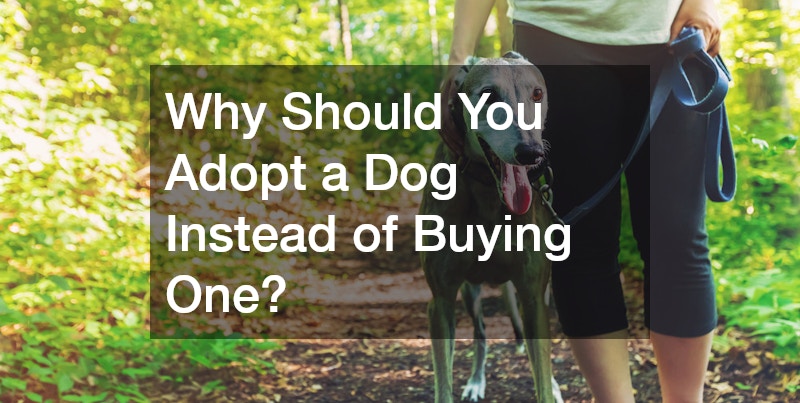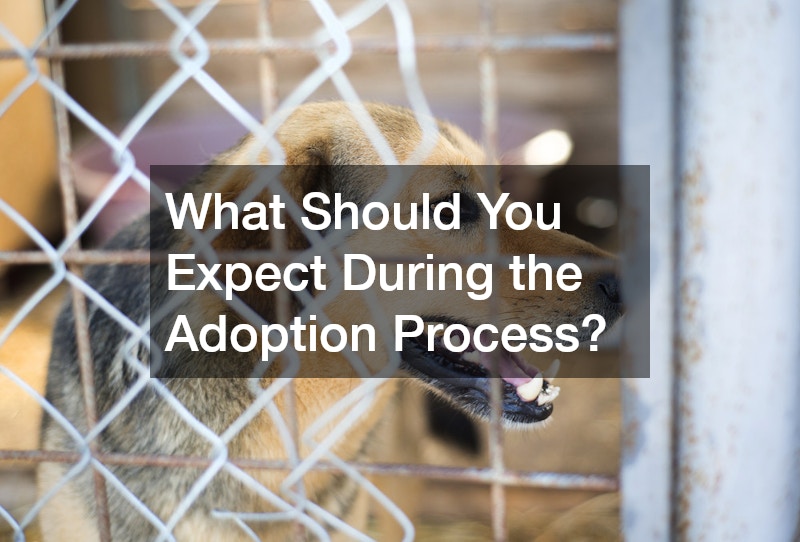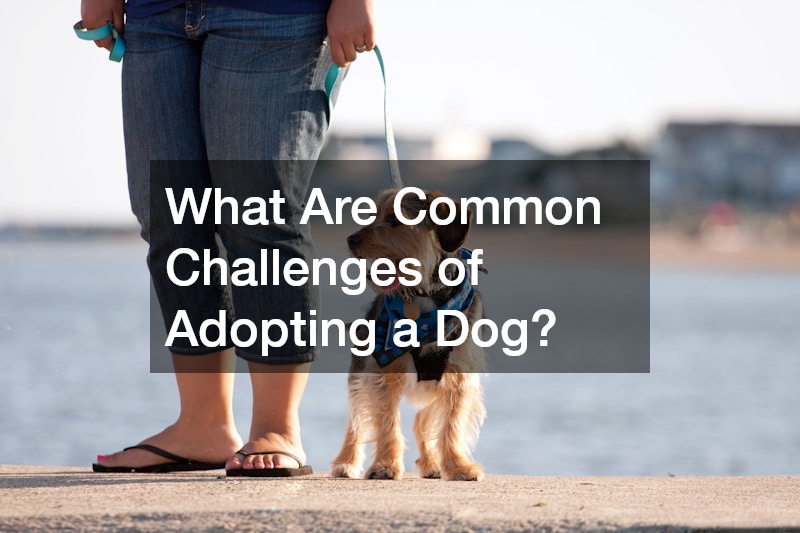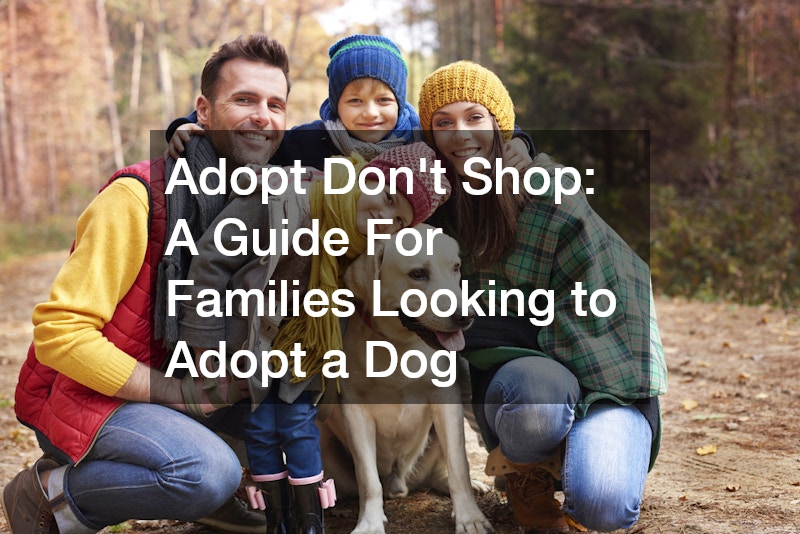Adopting a dog can be a transformative experience for families. Dogs offer companionship, joy, and love, making them cherished members of any household. However, deciding to adopt a dog is a commitment that requires careful consideration and preparation. This guide provides a comprehensive overview for families considering adoption, covering each step in the process and offering advice to make the experience smooth and successful. By choosing to adopt rather than buy, you’re not only gaining a new family member but also giving a dog a chance at a better life, directly supporting the “adopt, don’t shop” philosophy. With the right approach, your family can create a lasting bond with a loyal, grateful companion. Here’s everything you need to know to make this journey rewarding and fulfilling.
1. Why Should You Adopt a Dog Instead of Buying One?
Many families start their journey by asking, “should we follow the adopt, don’t shop” philosophy? The “adopt, don’t shop” philosophy is more than a slogan; it’s a movement that supports animals’ welfare. Adopting has numerous benefits, including reducing pet overpopulation, giving dogs a second chance, and often being more affordable than buying from a breeder.

The Benefits of Adoption Over Purchasing
The advantages of adopt, don’t shop, go beyond the cost. Adopting a dog offers a range of benefits, including access to dogs who have already been socialized and may even be leash-trained, simplifying the process of leash training a puppy if you choose a young dog. Additionally, shelter dogs often come with an initial health check-up, vaccinations, and, in some cases, basic training, which may not be included when purchasing a dog from a breeder.
How Adoption Helps Reduce Overpopulation
One of the most significant reasons to “adopt, don’t shop” is that it directly impacts the pet overpopulation crisis. Thousands of dogs are surrendered or abandoned every year. By choosing to adopt, families can play an essential role in alleviating this issue by providing homes to dogs in need, helping reduce the number of dogs in shelters, and making space for others awaiting adoption.
The Emotional Rewards of Giving a Dog a Second Chance
Dogs are known for their loyalty, and when you “adopt, don’t shop”, you’re giving a dog a new chance at a fulfilling life. Many families find the experience of rescuing a dog profoundly rewarding. The bond between an adopted dog and their family can be even stronger, as adopted dogs often display gratitude and a deep connection to their adopters.
2. What Are the Initial Steps to Take When Considering Adoption?
Once the decision to adopt is made, it’s essential to take preparatory steps to ensure the adoption process is successful.
Researching Breeds and Assessing Family Needs
Different breeds have different needs, so it’s important to consider energy levels, size, grooming needs, and temperament. Additionally, consider whether you’re looking for a puppy, which may require more training or an older dog that may already have training.
Preparing Your Home for a New Pet
Before bringing your new dog home, you’ll want to make the space welcoming and safe. Hardwood flooring, for instance, can be beneficial in a home with pets, as it’s easier to clean and maintain compared to carpets. Make sure hazardous items are out of reach, set up a cozy sleeping area, and have food, water, toys, and grooming supplies ready.
Finances: Understanding the Costs of Dog Care
Budgeting for dog care is crucial, as expenses can add up. Costs will include food, grooming, and regular vet visits. It’s also wise to plan for unexpected expenses, such as the services of animal urgent care. Emergency care can be costly, so having a financial plan in place is essential for your peace of mind.
3. How to Find a Reputable Animal Shelter or Rescue
Choosing the right shelter or rescue is essential to finding a healthy, happy dog that suits your family’s needs.
Locating Shelters and Rescues in Your Area
Begin by searching online for local shelters and rescues. Websites like Petfinder and Adopt-a-Pet can be excellent resources for finding dogs near you. Look for shelters with positive reviews, transparency about their animals, and staff who are willing to answer your questions.
The Role of Foster Networks During Adoption
Foster networks play a critical role in dog adoption. These networks house dogs temporarily, allowing them to adjust to life outside the shelter. Often, foster caregivers provide insight into a dog’s personality and behavior, which can help families make informed decisions.
Questions to Ask When Visiting Shelters
When visiting shelters, ask questions about the dog’s background, health, and behavior. You’ll also want to inquire about any specific needs the dog may have and ask if they offer access to a mobile groomer or regular vet services. Knowing a dog’s temperament and history can help you understand if they are the right fit for your family.
4. What Should You Expect During the Adoption Process?
Understanding the adoption process can help you prepare for what’s ahead and manage your expectations.

Application Procedures and Approval Timeframes
Shelters often have an application process to ensure dogs are placed in safe, permanent homes. Be prepared to provide information about your living situation, family members, and previous pet experience. Approval timeframes can vary, so patience is key.
The Meet-and-Greet: Ensuring Compatibility
Most shelters will arrange a meet-and-greet, where you can spend time with the dog you’re considering. This is an opportunity to observe how they interact with your family and other pets. Make sure you feel comfortable with their energy level and temperament, as this meeting is critical to finding the right match.
What Paperwork is Required?
The paperwork involved in adopting a dog typically includes an adoption agreement, medical records, and any necessary transfer documents. If the dog hasn’t yet been spayed or neutered, you may be required to schedule this procedure with a vet clinic.
5. How to Choose the Right Dog for Your Family?
Selecting the right dog is one of the most important steps in the adoption process. Consider factors that will impact your day-to-day life with your new pet.
Assessing Energy Levels and Temperaments
Different breeds and even individual dogs have varying energy levels. Some dogs may require daily long walks or play sessions, while others may be content with minimal exercise. Ensure that the dog’s energy level aligns with your family’s lifestyle.
Considering Age: Puppies vs. Adult Dogs
While puppies may be adorable, they come with added responsibilities such as leash training, housebreaking, and higher energy demands. Older dogs, on the other hand, may already be trained and require less supervision, making them ideal for families with young children.
Understanding Breed Characteristics and Needs
Breed characteristics, such as grooming needs, health issues, and exercise requirements, can significantly impact your experience as a pet owner. Educate yourself on the specific needs of the breed or mix you’re interested in to ensure compatibility with your family.
6. How to Introduce an Adopted Dog to Your Home?
The transition to a new home can be overwhelming for an adopted dog. Taking gradual steps will ease this process and set the foundation for a successful adjustment.
Creating a Safe and Welcoming Environment
Prepare a comfortable space for your new dog, with a bed, toys, and food and water bowls. Some dogs may need time to adjust, so start by allowing them to explore a designated area. If you plan on using dog overnight boarding services, it can be helpful to introduce this concept gradually so they become accustomed to short absences.
Introducing the Dog to Family Members and Other Pets
Introduce your new dog to family members one at a time, allowing them to build trust slowly. If you have other pets, keep initial introductions brief and supervised to ensure positive interactions.
Managing the Adjustment Period
During the adjustment period, your dog may display signs of stress or anxiety. Patience and consistency in routines can help your dog settle in more quickly. Avoid overwhelming them with new experiences, and give them space to decompress as needed.
7. What Are the Common Challenges of Adopting a Dog?
Choosing to go the adopt, don’t shop route may come with challenges, including behavioral issues and health concerns. However, with patience and proper resources, these obstacles can be managed.

Dealing with Behavioral Issues and Anxiety
Adopted dogs may exhibit fear or anxiety due to previous experiences. Basic training, positive reinforcement, and creating a stable environment can help. If you’re facing persistent challenges, consult a professional trainer for additional support.
Understanding and Addressing Health Concerns
Adopted dogs may have health issues, especially if they were neglected or abandoned. Regular visits to the vet clinic and monitoring your dog’s health can prevent or address many issues. In case of emergencies, having access to an emergency veterinarian is vital.
Building Trust and Strengthening Bonds
Building trust with an adopted dog may take time, particularly if they have experienced neglect. Establishing routines, using positive reinforcement, and being patient are essential to creating a strong bond and sense of security.
8. How to Ensure Your Adopted Dog Stays Healthy?
Maintaining your dog’s health is a lifelong commitment that requires routine care, exercise, and a balanced diet.
Routine Vet Visits and Vaccinations
Regular check-ups at the vet clinic are crucial to your dog’s well-being. Staying up-to-date with vaccinations and preventive care will help protect your dog from illness.
Nutrition and Exercise Requirements
Each dog has unique dietary needs based on their age, breed, and activity level. Proper nutrition and regular exercise support animal metabolism, keeping them healthy and active.
Recognizing Signs of Distress or Illness
Paying attention to changes in behavior or appetite can alert you to potential health issues. Addressing these signs early by consulting your vet can prevent further complications.
9. Why Is Training Important for Adopted Dogs?
Training plays a vital role in helping adopted dogs adapt to their new home and family life. Proper training can prevent unwanted behaviors and foster a positive relationship.

The Basics of Dog Training and Commands
Begin with basic commands like “sit,” “stay,” and “come.” Consistent training will reinforce good behavior, making it easier to manage your dog both at home and in public. If your dog spends time outdoors, be mindful of lawn care service, as certain chemicals can be harmful.
Utilizing Positive Reinforcement Techniques
Positive reinforcement, such as treats and praise, is an effective way to encourage good behavior. Avoid punishment-based training methods, as these can create fear and anxiety in your dog.
When and How to Seek Professional Help
Some behaviors may require professional intervention. Dog trainers or behaviorists can offer specialized support to address issues such as aggression, separation anxiety, or extreme fearfulness.
10. Where to Find Resources and Support for Adopters?
Many resources are available for those looking to join the adopt, don’t shop movement, including online communities, training classes, and social meetups.
Online Communities and Forums
Joining online forums or social media groups can connect you with other dog owners who share advice and experiences. These platforms offer valuable support and insights into common challenges faced by adopters.
Local Dog Parks and Socialization Meetups
Dog parks provide opportunities for your dog to socialize and expend energy. Some areas may also host organized socialization meetups, which are beneficial for dogs and owners alike.
Accessing Training and Behavioral Support Services
Training facilities and services, including your local dog groomer, can be helpful as your dog adjusts to their new environment. Many trainers and grooming services also offer boarding, allowing you to maintain routines even when you’re away.
Joining the adopt, don’t shop movement can be a rewarding journey, bringing joy and companionship to any family. By understanding the essential aspects of adoption and asking the right questions, you’ll ensure a smooth transition for your new family member. Embrace the “adopt, don’t shop” philosophy, and remember that the commitment you’re making is one of compassion, care, and lifelong companionship. Adopting means providing a loving, stable home for a dog who may have faced hardships, and the bond you’ll create will be uniquely rewarding. With patience, love, and dedication, your adopted dog will become a cherished part of your family for years to come.
Conclusion
Adopting a dog can be a transformative experience for families. Dogs offer companionship, joy, and love, making them cherished members of any household. However, deciding to adopt a dog is a commitment that requires careful consideration and preparation. This guide provides a comprehensive overview for families considering adoption, covering each step in the process and offering advice to make the experience smooth and successful. By choosing to adopt rather than buy, you’re not only gaining a new family member but also giving a dog a chance at a better life, directly supporting the “adopt, don’t shop” philosophy. With the right approach, your family can create a lasting bond with a loyal, grateful companion. Here’s everything you need to know to make this journey rewarding and fulfilling.
